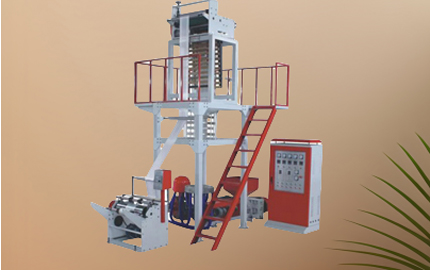Blown film extrusion is a cornerstone of modern plastic manufacturing, producing thin plastic films used in packaging, agriculture, construction, and more. This versatile process creates seamless, tubular films with uniform thickness and exceptional strength. Below, we explore the fundamentals of blown film extrusion, its machinery, process stages, applications, and key considerations.
A film blowing machine is industrial equipment designed to produce plastic films through blown film extrusion. It melts polymer resin, extrudes it through a circular die, and inflates it into a bubble using air pressure. The bubble is then cooled, collapsed, and wound into rolls. This method is ideal for creating high-quality, flexible films with adjustable thickness and width.
The blown film extrusion process transforms raw plastic resin into a continuous tubular film. Key steps include:
Melting: Resin pellets are fed into an extruder, where heat and shear forces melt them into a viscous fluid.
Extrusion: The molten polymer is forced through a circular die, forming a hollow tube.
Inflation: Compressed air is injected into the tube, expanding it into a bubble to achieve the desired diameter and thickness.
Cooling: Air rings or water quench systems solidify the film.
Collapsing and Winding: The cooled bubble is flattened and wound into rolls for further processing.
Material Preparation: Resins (e.g., LDPE, LLDPE, HDPE, PP) are dried (if hygroscopic) and mixed with additives like UV stabilizers or slip agents.
Extrusion: The extruder screw conveys, compresses, and melts the resin. Temperature zones are carefully controlled.
Die Formation: The molten polymer exits the die as a thin-walled tube. Die design (e.g., spiral mandrel) ensures uniform flow.
Bubble Inflation: Air pressure controls bubble diameter (related to the "blow-up ratio") and film thickness.
Cooling: External air rings and internal bubble cooling (IBC) systems stabilize the bubble.
Haul-Off and Winding: Nip rollers collapse the bubble, and tension control ensures wrinkle-free winding.
Blown films are ubiquitous in industries requiring lightweight, durable, and flexible materials:
Packaging: Shopping bags, food packaging (barrier films), stretch films.
Agriculture: Greenhouse films, mulch films, silage bags.
Construction: Vapor barriers, protective sheets.
Medical: Sterile packaging, IV bags.
Consumer Goods: Trash bags, cling wraps.
Extruder: Single or twin-screw systems that melt and homogenize the resin.
Die Head: Shapes the molten polymer into a tube; critical for film uniformity.
Air Ring: Cools the bubble exterior.
Internal Bubble Cooling (IBC) System: Manages airflow inside the bubble for precise cooling.
Nip Rolls: Collapse the bubble into flat film layers.
Winder: Collects the film into rolls with controlled tension.
Control Systems: Monitor parameters like temperature, pressure, and speed.
Cost Efficiency: Lower tooling costs compared to other processes (e.g., injection molding).
Material Flexibility: Works with a wide range of polymers, including blends and recycled materials.
Film Properties: Offers superior impact resistance and puncture resistance due to biaxial orientation during blowing.
Versatility: Produces both mono-layer and multi-layer films (via co-extrusion) for specialized applications (e.g., barrier films for food packaging).
Width and Thickness Range: Can produce very wide films (up to several meters) and thin gauges (down to 10 microns).
What materials can be used in blown film machine?
Common resins include polyethylene (LDPE, LLDPE, HDPE), polypropylene (PP), and biodegradable polymers (PLA, PBAT). Additives enhance properties like UV resistance or anti-static behavior.
How does blown film extrusion compare to cast film extrusion?
Blown Film machine: Produces tubular films with balanced mechanical properties; slower cooling allows for higher clarity.
Cast Film machine: Creates flat films with faster cooling, offering superior optical clarity but less toughness.
What are the key factors affecting film quality?
Melt temperature uniformity, blow-up ratio, cooling efficiency, and die design. Contamination or moisture in resin can also cause defects.
How can I improve process efficiency?
Optimize screw design for faster melting, use advanced IBC systems for cooling, and implement real-time monitoring to reduce downtime.

Blown film extrusion remains a cornerstone of the plastics industry, enabling the production of lightweight, durable films for countless applications. By understanding its machinery, process dynamics, and optimization strategies, manufacturers can leverage this technology to meet evolving market demands for sustainable, high-performance packaging and industrial solutions.